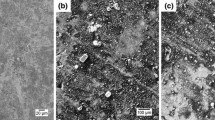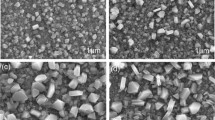Abstract
Oxide films on Alloy 600 and Alloy 690 formed during exposure to the simulated primary side water of a pressurized water reactor were characterized using hard X-ray photoelectron spectroscopy. The specimens were immersed in a solution containing 500 ppm B + 2 ppm Li with or without dissolved hydrogen at 320 or 360 °C for 24 h. Photoelectrons generated in the oxide films with thickness up to 25 nm and in the substrate alloy underneath the oxide films could be observed simultaneously without any destructive techniques such as sputtering. The oxide films were composed of an inner oxide layer of mainly Cr and a covering hydroxide layer of Ni and Cr, with needle-like oxides distributed on the outermost surface. In addition, alloyed Cr was depleted from the substrate alloy directly underneath the oxide layer. Even though the Ni-based alloys examined were mainly composed of Ni, almost no Ni oxide was present in the oxide films formed in solution with dissolved hydrogen. Most of Ni was incorporated as hydroxide. However, Cr was incorporated both in the hydroxide and the inner oxide layers.






Similar content being viewed by others
References
Bond AP, Uhlig HH (1960) Corrosion behavior and passivity of nickel-chromium and cobalt-chromium alloys. J Electrochem Soc 107:488–493
Myers JR, Beck FH, Fontana MG (1965) Anodic polarization behavior of nickel-chromium alloys in sulfuric acid solutions. Corrosion 21:277–287
Hodge FG, Wilde BE (1970) Effect of chloride ion on the anodic dissolution kinetics of chromium-nickel binary alloys in dilute sulfuric acid. Corrosion 26:146–150
Kim HJ, Mitton DB, Latanision RM (2010) Corrosion behavior of Ni-base alloys in aqueous HCl solution of pH 2 at high temperature and pressure. Corros Sci 52:801–809
Lefaix-Jeuland H, Marchetti L, Perrin S, Pijolat M, Sennour M, Molins R (2011) Oxidation kinetics and mechanisms of Ni-base alloys in pressurised water reactor primary conditions: Influence of substrate defects. Corros Sci 53:3914–3922
Schenk HJ (1976) Investigation of tube failures in Inconel 600 steam generator tubing at KWO Obrigheim. Mater Perform 15(3):25–33
Shen CH, Shewmon PG (1990) A mechanism for hydrogen-induced intergranular stress corrosion cracking in Alloy600. Metall Trans A 21A:1261–1271
Andresen PL (1991) Fracture mechanics data and modeling of environmental cracking of nickel-base alloys in high-temperature water. Corrosion 47:917–938
Andresen PL, Hickling J, Ahluwalia A, Wilson J (2008) Effects of hydrogen on stress corrosion crack growth rate of nickel alloys in high-temperature water. Corrosion 64:707–720
Nagano H, Yamanaka K, Minami T, Inoue M, Yonezawa T, Onimura K, Sasaguri N, Kusakabe T (1985) Proc. 2nd int. symp. environmental degradation of materials in nuclear power systems - water reactors, Monterey, California
Andresen PL, Morra MM, Hickling J, Ahluwalia A, Wilson J (2007) PWSCC of Alloy 690, 52 and 152. Proc. 13th int. symp. environmental degradation of materials in nuclear power systems– water reactors, Canadian Nuclear Soc August 2007
Arioka K, Yamada T, Miyamoto T, Terachi T (2011) Dependence of stress corrosion cracking of Alloy 690 on temperature, cold work, and carbide precipitation - role of diffusion of vacancies at crack tips. Corrosion 67:035006-1-18
McIntyre NS, Zetaruk DG, Owen D (1979) X-ray photoelectron studies of the aqueous oxidation of Inconel-600 Alloy. J Electrochem Soc 126:750–760
Shibata T, Fujimoto S (1987) Straining electrode behavior of Cr-Fe and Cr-Ni alloys in high temperature and high pressure borate buffer solution. Trans Japan Inst Metals 28:424–433
Szklarska-Smialowska Z, Lai WK, Xia Z (1990) Oxide Films Formed on Alloy 600 in Lithiated Water at 25 to 350 °C. Corrosion 46:853–860
Angeliu TM, Was GS (1993) The effect of chromium, carbon, and yttrium on the oxidation of nickel-base alloys in high temperature water. J Electrochem Soc 140:1877–1883
Carrette F, Lafont MC, Chatainier G, Guinard L, Pieraggi B (2002) Analysis and TEM examination of corrosion scales grown on Alloy 690 exposed to pressurized water at 325 C. Surf Interface Anal 34:135–138
Nakagawa T, Totsuka N, Terachi T, Nakajima N (2003) Influence of dissolved hydrogen on oxide film and PWSCC of Alloy 600 in PWR primary water. J Nucl Sci Technol 40:39–43
Terachi T, Totsuka N, Yamada T, Nakagawa T, Deguchi H, Horiuchi M, Oshitani M (2003) Influence of dissolved hydrogen on structure of oxide film on Alloy 600 formed in primary water of pressurized water reactors. J Nucl Sci Technol 40:509–516
Machet A, Galtayries A, Zanna S, Klein L, Maurice V, Jolivet P, Foucault M, Combrade P, Scott P, Marcus P (2004) XPS and STM study of the growth and structure of passive films in high temperature water on a nickel-base alloy. Electrochim Acta 49:3957–3964
Le Canut JM, Maximovitch S, Dalard F (2004) Electrochemical characterization of nickel-based alloys in sulphate solutions at 320 °C. J Nucl Mater 334:13–27
Takeda Y, Shoji T, Bojinov M, Kinnunen P, Saario T (2006) In situ and ex situ characterisation of oxide films formed on strained stainless steel surfaces in high-temperature water. Appl Surf Sci 252:8580–8588
Bojinov M, Galtayries A, Kinnunen P, Machet A (2007) Marcus P (2007) Estimation of the parameters of oxide film growth on nickel-based alloys in high-temperature water electrolytes. Electrochim Acta 52:7475–7483
Marchetti L, Perrin S, Wouters Y, Martin F, Pijolat M (2010) Photoelectrochemical study of nickel base alloys oxide films formed at high temperature and high pressure water. Electrochim Acta 55:5384–5392
Betova I, Bojinov M, Karastoyanov V, Kinnunen P, Saario T (2012) Effect of water chemistry on the oxide film on Alloy 690 during simulated hot functional testing of a pressurised water reactor. Corros Sci 58:20–32
Ohtsuka T, Hamaguchi Y, Sakairi M, Fushimi K, Sakakibara Y, Nakayama G (2013) Proc. JSCE Mater Environ 2013:79–82
Kin WS, Tsuchiya H, Sato M, Son JY, Machida M, Jung KT, Fujimoto S, Electrochemical properties of oxide films formed on cold worked Alloy 600 and Alloy 690 in simulated PWR primary side environments. submitted to Zairyo-to-Kankyo
Nagayama M, Cohen M (1962) The Anodic oxidation of iron in a neutral solution: I. The nature and composition of the passive film. J Electrochem Soc 109:781–790
Sato N, Okamoto G (1963) Anodic passivation of nickel in sulfuric acid solutions. J Electrochem Soc 110:605–614
Sato N, Cohen M (1964) the kinetics of anodic oxidation of iron in neutral solution: I. Steady growth region. J Electrochem Soc 111:512–519
Seo M, Saito R, Sato N (1980) Ellipsometry and auger analysis of chromium surfaces passivated in acidic and neutral aqueous solutions. J Electrochem Soc 127:1909–1912
Asami K, Hashimoto K (1977) XPS determination of composition of alloy surfaces and surface oxides on mechanically polished iron-chromium alloys. Corros Sci 17:713–723
Olefjord I, Wegrelius L (1990) surface analysis of passive state. Corros Sci 31:89–98
De Vito E, Marcus P (1992) XPS study of passive films formed on molybdenum-implanted austenitic stainless steels. Surf Interface Anal 19:403–408
Marcus P, Grimal JM (1992) The anodic dissolution and passivation of Ni-Cr-Fe alloys studied by ESCA. Corros Sci 33:805–814
Jung RH, Tsuchiya H, Fujimoto S (2012) XPS Characterization of passive films formed on Type 304 stainless steel in humid atmosphere. Corros Sci 58:62–68
Kim WS, Tsuchiya H, Fujimoto S (2015) Electrochemical characterization of passive films on Ni-based alloys in acidic and neutral solutions. Materials Transactions 56:593–599
Elsener RA (1995) Ageing of passive films on stainless steels in sulfate solutions - XPS analysis. Mater Sci Forum 185–188:337–346
Biesinger MC, Payne BP, Lau LWM, Gerson A, Smart RSC (2009) X-ray photoelectron spectroscopic chemical state quantification of mixed nickel metal, oxide and hydroxide systems. Surf Interface Anal 41:324–332
Indig ME, McIlree AR (1979) High temperature electrochemical studies of the stress corrosion of Type 304 stainless steel. Corrosion 35:288–296
Tomlinson L (1981) Mechanism of corrosion of carbon and low alloy ferritic steels by high temperature water. Corrosion 37:591–596
42. Soulas R, Legras L, Cheynet M, Brechet Y (2013) Formation mechamisms and properties of oxide layers formed on 316L alloy in simulated PWR environment. Proc.16th int. conf. environmental degradation of materials in nuclear power systems– water reactors, NACE Asheville August 2013
Tougaard S (1998), Software packages to characterize surface nano-structures by analysis of electron spectra. http://www.quases.com
Tanuma S, Powell CJ, Penn DR (1994) Calculations of electron inelastic mean free paths. V. Data for 14 organic compounds over the 50–2000 eV range. Surf Interface Anal 21:165–176
Totsuka B, Szklarska-Smialowska Z (1987) Effect of Electrode Potential on the Hydrogen-Induced IGSCC of Alloy 600 in an Aqueous Solution at 350 C. Corrosion 43:734–738
Acknowledgments
This work was supported by the Priority Assistance of the Formation of Worldwide Renowned Centers of Research-Global COE Program “Center of Excellence for Advanced Structural and Functional Materials Designs” of the Ministry of Education, Sports, Culture, Science and Technology of Japan. The HAX-PES experiments were performed at the BL46 of SPring-8 with the approval of the Japan Synchrotron Radiation Research Institute (JASRI, project number 2009B1863).
Author information
Authors and Affiliations
Corresponding author
Rights and permissions
About this article
Cite this article
Fujimoto, S., Kim, WS., Sato, M. et al. Characterization of oxide films formed on Alloy 600 and Alloy 690 in simulated PWR primary water by using hard X-ray photoelectron spectroscopy. J Solid State Electrochem 19, 3521–3531 (2015). https://doi.org/10.1007/s10008-015-2817-8
Received:
Revised:
Accepted:
Published:
Issue Date:
DOI: https://doi.org/10.1007/s10008-015-2817-8




